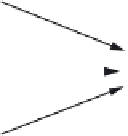Robotics Reference
In-Depth Information
Figure 47 illustrates a simple artificial neuron with three inputs, la-
belled i
1
,i
2
and i
3
. Associated with these three inputs are the three
weights: w
1
,w
2
and w
3
respectively. So the weighted sum of these
inputs—its
score
,
—is
×
×
×
[w
1
i
1
]
+
[w
2
i
2
]
+
[w
3
i
3
]
The sum total of this expression (
) determines the output from
the artificial neuron—this total is fed into the
activation function
which
decides how this particular artificial neuron should react to whatever total
it is fed, and it is this reaction that determines what output is sent from
this
neuron to act as the inputs for other neurons in the network. If
the total score is equal to or above a certain threshold then the artificial
neuron fires, otherwise it does not. In essence, the neuron fires if it
recognizes
that a particular pattern which it is examining has some special
characteristics. If the weighted sum of its inputs (i.e., its score) exceeds
the threshold, then the neuron recognizes the pattern as belonging to
some particular category of patterns. This is the real crux of the idea—
recognizing that a particular input pattern belongs to some specific class
of patterns. The task could be recognizing whether a photograph is of a
man or a woman, whether a voice is that of an adult or a child, whether
or not a piece of music was written by Brahms, whether a spoken word
was “one”, “two”, “three” or another digit. Just about any classification
task can be accomplished by a network of artificial neurons—an Artificial
Neural Network.
In order to function accurately as a classifier an ANN needs to have
its numerical weights—the strengths of its connections—set to suitable
values. In an ANN, an input to one neuron will often be an output
from another neuron, and the weights we have been referring to relate to
to
the
inputs
of
other
neurons
i
1
w
1
w
2
Activation
Function
i
2
Σ
w
3
i
3
Figure 47.
A simple artificial neuron








